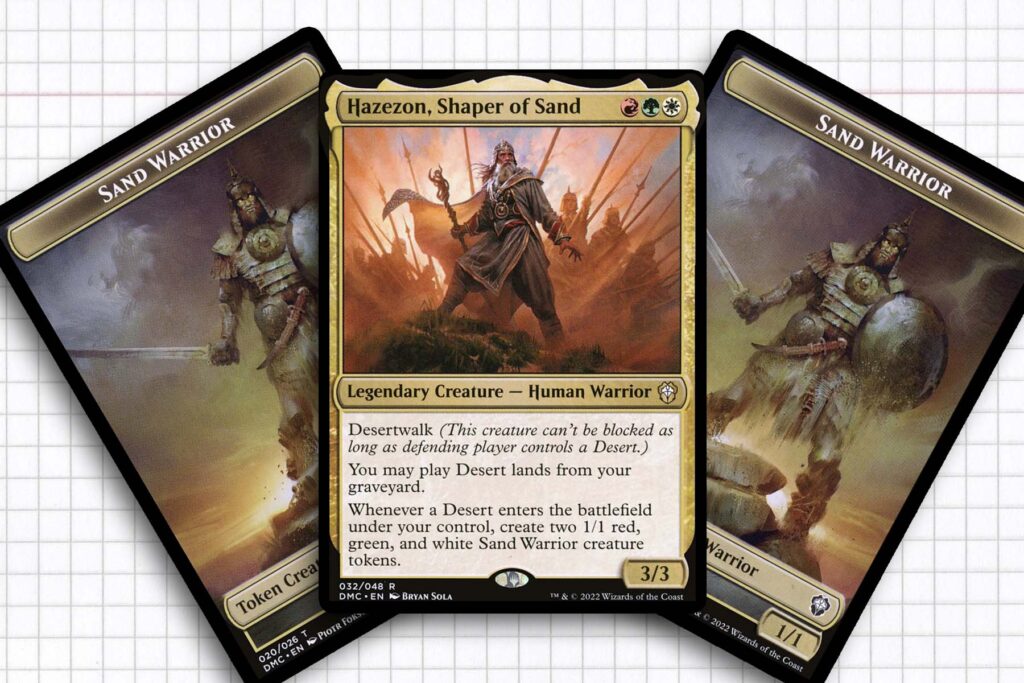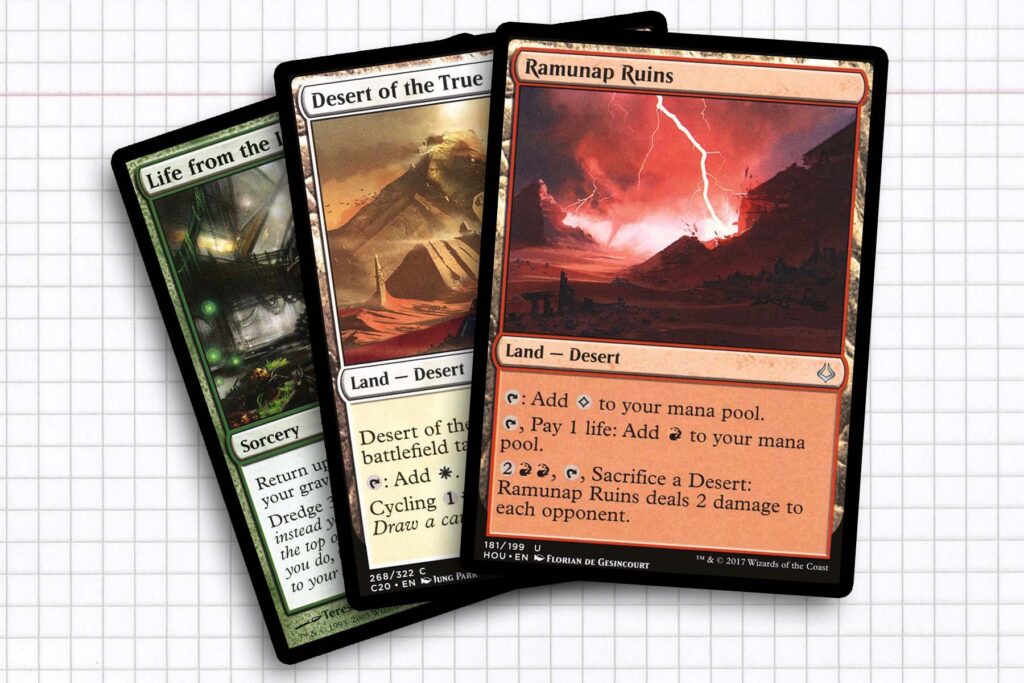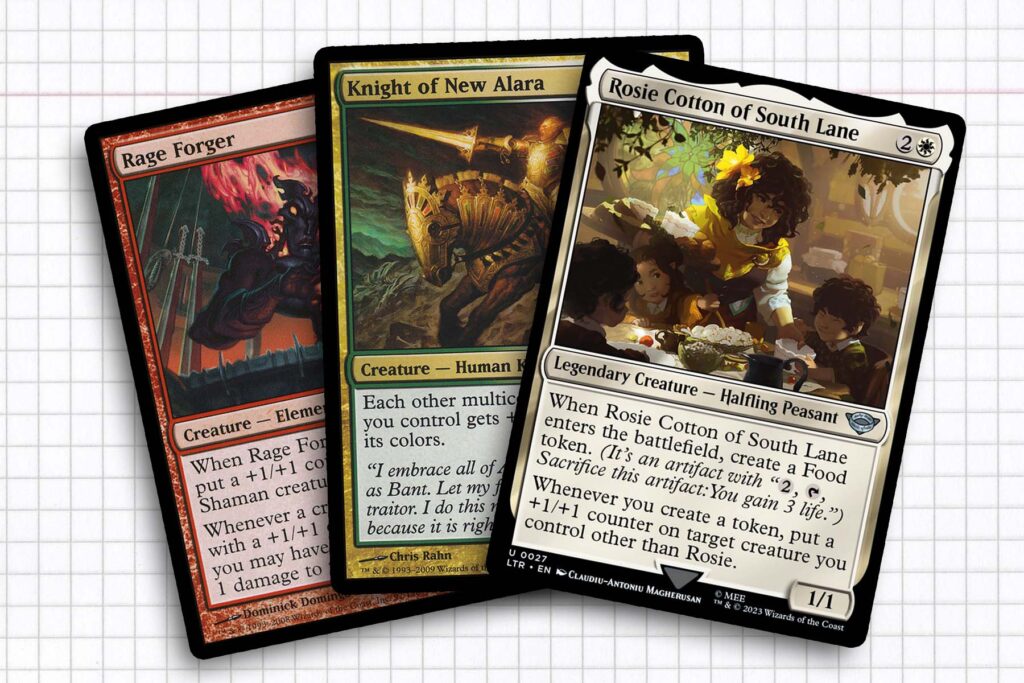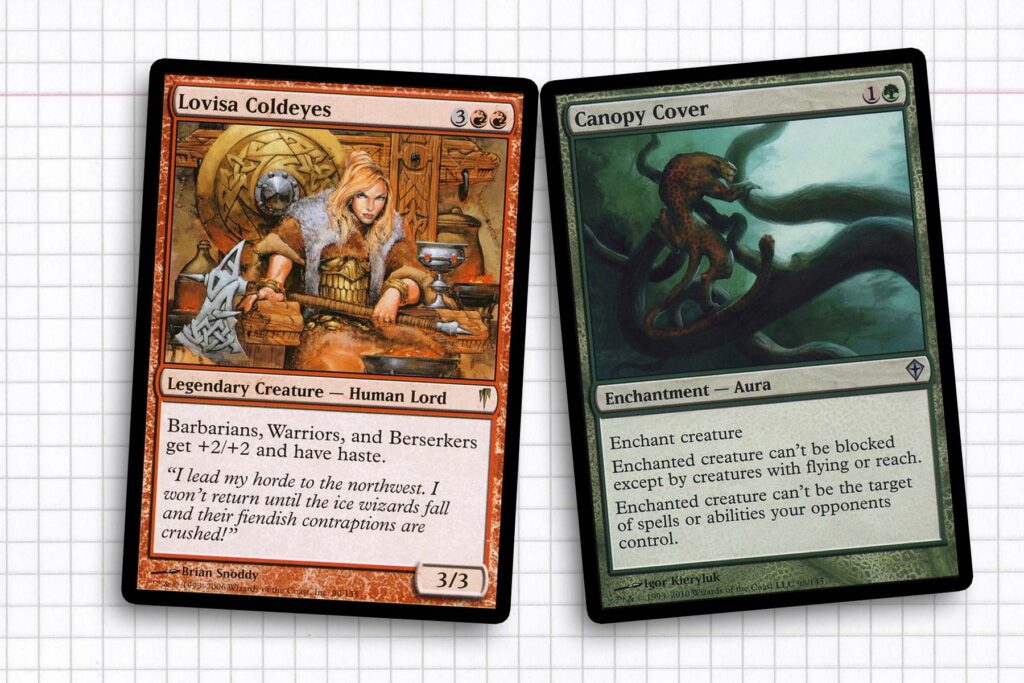Commander is a format which sometimes feels infinitely mutable. In fact, one of the highlights of the format for me is any general can be used in multiple ways, if you allow yourself to be open to new ideas. And sometimes the deck you set out to make is not the deck you end up with. Today is certainly one of those decks.
I have found the Legends Retold reimagining of old legendary creatures from Legends to be some of the most inspiring commanders of the last few years. There is almost always at least one occupying on the back of my mind as I teeter between topics for this column. And every so often, one of them will present itself in a way I finally deem worthy of the time and energy needed to write about them.
The original concept for Hazezon, Shaper of Sand and what would eventually manifest are two wildly different decks. My initial thought was I could take advantage of the unique landwalk ability Hazezon has, to create a Voltron deck unlike any I had built prior. But after a lot of consideration about synergies I had overlooked, a new, more compelling deck presented itself. And in a matter of days, the deck I set out to make became something wildly different.

Commander:
Creatures:
- Abzan Battle Priest
- Abzan Falconer
- Akki Battle Squad
- Battlefront Krushok
- Bazaar Trader
- Bramblewood Paragon
- Devilish Valet
- Grumgully, the Generous
- Kargan Warleader
- Knight of New Alara
- Lovisa Coldeyes
- Mirror-Style Master
- Ogre Battledriver
- Rage Forger
- Ramunap Excavator
- Rosie Cotton of South Lane
- Sosuke, Son of Seshiro
- Sylvan Safekeeper
- Unstoppable Ash
- Windbrisk Raptor
Artifact:
Enchantment:
- Blessing of the Nephilim
- Bower Passage
- Call for Unity
- Canopy Cover
- Holistic Wisdom
- Inspiring Leader
- Intangible Virtue
- Need for Speed
- Rise of the Hobgoblins
- Shared Animosity
- Shivan Harvest
- Sigarda’s Summons
- Steely Resolve
- Virtue of Loyalty
Instant:
Sorceries:
- Blasphemous Act
- Divine Reckoning
- Harmless Offering
- Journey of Discovery
- Life from the Loam
- Restore
- Rush of Battle
- Shamanic Revelation
- Splendid Reclamation
- Summer Bloom
- Thrive
Lands:
- 6 Forest
- 4 Mountain
- 5 Plains
- Bountiful Promenade
- Clifftop Retreat
- Desert
- Desert of the Fervent
- Desert of the Indomitable
- Desert of the True
- Dunes of the Dead
- Endless Sands
- Gavony Township
- Ghost Quarter
- Hashep Oasis
- Hostile Desert
- Jetmir’s Garden
- Jungle Shrine
- Painted Bluffs
- Ramunap Ruins
- Reflecting Pool
- Rootbound Crag
- Scattered Groves
- Scavenger Grounds
- Shefet Dunes
- Sheltered Thicket
- Spectator Seating
- Spire Garden
- Sunpetal Grove
- Sunscorched Desert
- Survivors’ Encampment
The original concept for this deck was to take cues from a Najeela, the Blade-Blossom warriors-matter deck, focusing down to a three-color identity. The biggest change was going to focus more on being a Voltron deck which would utilize warrior typal effects to make Hazezon, Shaper of Sand as scary as possible. Obviously elements of warriors-matter still exist in this deck, like Rush of Battle and Bramblewood Paragon, but it was a careful examination of elements I felt were key to my deck that gradually opened my eyes up to a completely different strategy. Suddenly everything started snapping into place.

Ramunap Ruins, Desert of the True and Life from the Loam. Emblematic pieces of the land recursion strategy.
Investing in Real Estate
When I was first drawing up a deck skeleton, I figured there would be some consideration put into the mana base. That assumption started and ended with desertwalk. I assumed I would be using something like Bazaar Trader or Harmless Offering to donate one of my deserts to an opponent, so I would be able to make free attacks against them. Little did I realize how donating a desert was all well and good, but recurring them was going to be far more fruitful.
After a review of our available options, it’s hard to overlook how several deserts, like Hashep Oasis, Ramunap Ruins, Shefet Dunes, act as sacrifice outlets. This drove the second stage of decision making, as I was looking to maximize Hazezon’s triggers and make the sand warrior tokens the core of my creature base. Sacrifice engines beget recursion engines and suddenly, I found myself balancing on a very fine edge, which I’m not entirely sure I have mastered just yet. The more I assembled the deck, the more I realized that for what I was trying to do, the build required a higher than average land count: the end result being 42.
When it comes to land recursion, cards like Conduit of Worlds[mtg_card], [mtg_card]Life from the Loam, Ramunap Excavator, and Splendid Reclamation are probably familiar to many Commander players that have explored the archetype. In one form or another, my hope is that they can play strong roles in keeping my creature presence healthy. But pet cards Holistic Wisdom and Storm Cauldron are going to round out our toolbox and allow us to maximize Hazezon triggers. In fact, Holistic Wisdom was a prime factor in the decision to up the amount of lands the deck runs. It was too tempting to be able exile non-desert lands to get another Hazezon trigger.

Rosie Cotton of South Lane, Knight of New Alara, and Rage Forger. The wide swath of lord-effects we are using in this deck.
Every Creature, a Lord
This deck is looking to be strongly dependent on its commander. At first, I was thinking it would be in the form of the aforementioned voltron strategy. But because Hazezon is such a potent token maker, the non-token creature suite is built to augment and support the sand warrior tokens we are creating. This strategy developed after noticing the synergy between Hazezon, Shaper of Sand’s trigger and Rosie Cotton of South Lane, and realizing that the average token could conceivably be a 2/2. This led me to seek out more effects like Rosie, in the form of Bramblewood Paragon, Grumgully, the Generous, and Gavony Township, to make this theme more consistent.
All this help to get that critical first +1/+1 counter onto my creatures, opening us up to Abzan Battle Priest, Abzan Falconer, Battlefront Krushok, Rage Forger, and Sigarda’s Summons to act as another line of lord effects, this time adding new keywords to each of my creature tokens. Akki Battle Squad comes in as a strong contender, because it’s assumed we’ll have a modified creature all the time. And while there are a few more notable anthem-effects, Knight of New Alara is a gem that I see pulling a lot of weight for what this deck is trying to do.
Hopefully this deck can all coalesce in a deck potent at going wide on the regular. In fact, what we’re building towards our general is so important that Divine Reckoning was chosen as the perfect Wrath-effect, as it saves our general and allows us to regrow the battlefield after the fact.

Lovisa Coldeyes and Canopy Cover, some of the voltron pieces that have survived the change in deck focus.
Assembling Voltron
I didn’t completely abandon the Voltron strategy for this deck, as remnants of it can be seen in the auras like Blessing of the Nephilim and Canopy Cover. These cards are meant to solely support our general and use some of the aforementioned lord-effects to get a +1/+1 counter onto our general and then make him into a potent Voltron, in the event our land recursion is not going to get the job done. This backup plan added a level of legitimacy to what this deck was trying to do, which left me happy with the end product.
While this deck remains untested against an actual metagame at this point, I will say I am looking forward to building this deck in person so I can take it out for a spin and see how it plays. I think my favorite part is how this is a typal deck not entirely dependent on creature type as elements, like +1/+1 counters. This adds a dimension to the deck which allows it to draw in things like the modified keyword and the Abzan lords.
In a few weeks, we will be looking at the Doctor Who Commander decks and the lore around them. And soon after, I can only assume we will be exploring The Lost Caverns of Ixalan, but I hope to get one more of my Legends Retold concoctions built before years end. Until then, thanks for reading.
Ryan Sainio (he/him) is a Graphic Designer exploring the Commander format and Magic history on a regular basis. Notable decks that value flavorful and fun gameplay over competitively optimized decks include Shattergang Eldrazi, Doran Soul Sisters, and Chatterfang ProsBloom.
MTG Content Creator Awards 2022 nominee: Format Specialty Writing & Excellence in Writing Overall

